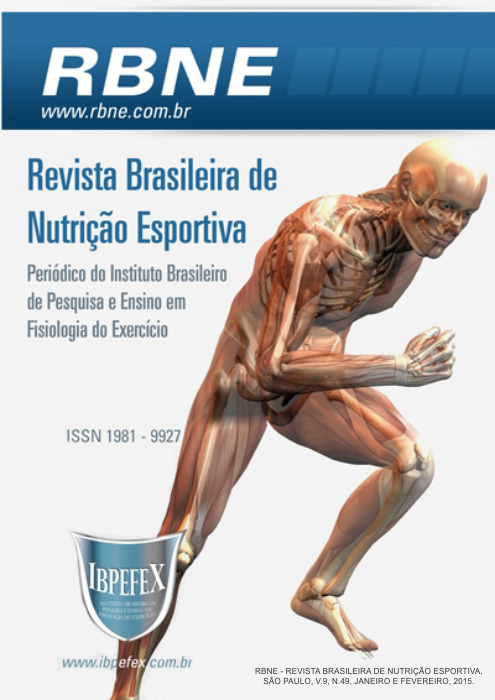Assessment of the labeling and nutrition facts of imported protein supplements in Brazil
Abstract
Sports practice has clear health benefits inmoderate levels. However, the goalfor optimization of performance and aesthetic enhancement has favored the selling and intake of various products said to be performance enhancers. Consumers generally don’t show interest on acquiring information concerning supplement intake, and end up becoming supporters of the growing market of dietary supplements. This studymain purpose was to evaluate the adequacy of nutrition facts from imported protein supplements to its original information and the national laws regarding supplements and packaged products. The verification of mandatory labeling information was based on RDC Nº 18/2010 and RDC nº 259/2002 resolutions from the Ministry of Health. We collected information only from protein supplements sold in specialized stores in the city of Niterói, Rio de Janeiro. A total of 27 labels were analyzed. Among the evaluated products, 89% (n=24) had its nutrition facts written in Portuguese and 11%(n=3) in their original language. Regarding irregularities, only 7,4% (n=2) of the products were in full accordance with the resolutions of reference, whereas 92,6% (n=25) contained some inaccuracies at their labels. Our results indicate that the labeling of imported protein supplements, regarding nutrition facts, has no proper standardization, disobeying in most cases one or more requisites established by existing national resolutions.
References
-Brasil. Ministério da Saúde. ANVISA 2002. Regulamento técnico para Rotulagem de Alimentos Embalados. Núm. 259. 2002.
-Brasil. Ministério da Saúde. ANVISA 2010. Regulamento técnico sobre alimentos para atletas. Núm. 18. 2010.
-Brownie, S. The development of the US and Australian dietary supplement regulations. Complementary Therapies in Medicine. Vol. 13. p.191-198. 2005.
-Carvalho, P. G.; Araújo, W. M. C. Rotulagem de suplementos vitamínicos e minerais: uma revisão das normas federais. Ciência & Saúde Coletiva. Vol. 13. p. 779-791. 2008.
-Chicón, R.; Belloque, J.; Alonso, E.; López-Fandiño, R. Antibody binding and functional properties of whey protein hydrolysates obtained under high pressure. Food Hydrocolloids. Vol. 23. p. 593-599. 2009.
-Dodge, T. L.; Jaccard, J. J. The effect of High School sports participation on the use of performance-enhancing in young adulthood. Journal of Adolescent health. Vol. 39. p. 367-373. 2006.
-Foegeding, E. A.; Davis, J. P.; Doucet, D.; McGuffey, M. C. Advances in modifying and understanding whey protein functionality. Trends in Food Science & Technology. Vol. 13. p. 15-159. 2002.
-Foiland, K.; Koszewski, w.; Hingst, J.; Kopecky, L. Nutritional supplement use amongcollege athletes and their source of information. International Journal of Sport Nutrition and Exercise Metabolism. Vol. 14. p. 104-120. 2004.
-Gerberding, S. J.; Byers, C. H. Preparative ion-exchange chromatography of proteins from dairy whey. Journal of Chromatography A. Vol. 808. p. 141-151. 1988.
-Lan, Q.; Bassi, A.; Zhu, J.; Margaritis, A. Continuous Protein Recovery from Whey Using Liquid-Solid Circulating Fluidized Bed Ion-Exchange Extraction. Biotechnology and Bioengineering. Vol. 78. Núm. 2. 2002.
-Moreira, S. S. P.; Cardoso, F. T.; Souza, G. G.; Silva, E. B. Avaliação da adequação da rotulagem de suplementos esportivos. Corpus et Scientia. Vol. 9. Núm. 2. p. 45-55. 2013.
-Mourouzidis-Mourouzis, S. A.; Karabelas, A. J. Whey protein fouling of microfiltration ceramic membranes-Pressure effects. Journal of Membrane Science. Vol. 282. p. 124-132. 2006.
-Panyam, D.; Kilara, A. Enhancing the functionality of food proteins by enzymatic modification. Trends in Food Science & Technology. Vol. 71.1996.
-Pereira, I. A. T. S. A vigorexia e os esteróides anabolizantes andrógenos em levantadores de peso. Dissertação de Licenciatura apresentada à Faculdade de Desporto da Universidade do Porto. Porto. 2009.
-Petróczi, A.; Naughton, D. P. Supplement use in sport: is there a potentially dangerous incongruence between rationale and practice?
Journal of Occupational Medicine and Toxicology. Vol. 2. Núm. 4. 2007.
-Pinheiro, M. C.; Navarro, A. C. Adequação da rotulagem nutricional de repositores energéticos comercializados no Distrito Federal. Revista Brasileira de Nutrição Esportiva. São Paulo. Vol. 2. Núm. 9. p. 106-118. 2008.
-Radimer, K.; Bindewald, B.; Hughes, J.; Ervin, B.; Swanson, C.; Picciano, M. F. Dietary supplement use by US adults: Datafrom the National Health and Nutrition examination survey, 1999-2000. Am J Epidemiol. Vol. 160. p. 339-349. 2004.
-Samuelsson, G.; Dejmek, P.; Trägardh, G.; Paulson, M. Minimizing whey protein retention in cross-flow microfiltration of skim milk. Int. Dairy Journal. Vol. 7. p. 237-242. 1997.
-Scrimshaw, N. S. Dietary Protein and Growth: Presentation, Comments, and Authors’ Response. Food and Nutrition Bulletin. Vol. 24. Núm. 2. 2003.
Authors who publish in this journal agree to the following terms:
- Authors retain the copyright and grant the journal the right of first publication, with work simultaneously licensed under the Creative Commons Attribution License BY-NC which allows the sharing of the work with acknowledgment of the authorship of the work and initial publication in this journal.
- Authors are authorized to enter into additional contracts separately for non-exclusive distribution of the version of the work published in this journal (eg, publishing in institutional repository or book chapter), with acknowledgment of authorship and initial publication in this journal.
- Authors are allowed and encouraged to post and distribute their work online (eg, in institutional repositories or on their personal page) at any point before or during the editorial process, as this can bring about productive change as well as increase impact and impact. citation of published work (See The Effect of Free Access).






